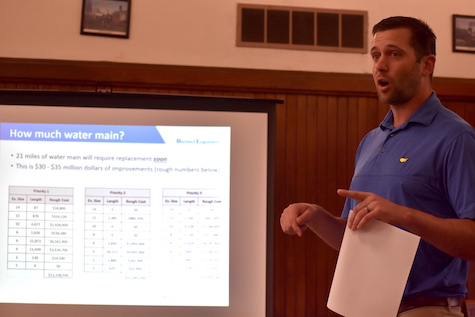Medina told ‘antiquated’ water system needs $30 million-plus in new lines
Village urged to address $12.5 million in ‘priority one’ replacements

Photo by Tom Rivers: Matt Zarbo, a managing engineer with Barton & Loguidice, said 21 miles of waterlines in the village need to be replaced in the next 10 to 15 years. He urged the Village Board to work on putting in new infrastructure to replace waterlines that are at least 75 years old.
MEDINA – The village’s water distribution system has more than 20 miles of waterlines that are soon in need of replacement, and the upgrades wouldn’t come cheap, the Village Board was told on Monday by an engineer with Barton & Loguidice.
The estimate to replace 21 miles of waterlines would be in the $30 million to $35 million range, said Matt Zarbo, a managing engineer with Barton & Loguidice.
The village’s water distribution system was studied by the engineering firm, and Zarbo said many of the waterlines are at least 75 years old, with some dating pre-1900s.
“You can’t do all at once,” Zarbo told the board on Monday. “It’s not fiscally feasible but you need to plan for now. Your system is definitely antiquated.”
He grouped the waterlines in need of replacement into three priority groups. He based that ranking partly on whether there is low water pressure in the lines and a history of leaks.
Priority one includes 40,118 linear feet, nearly 8 miles, and would cost an estimated $12,338,550.
Priority two covers 38,487 linear feet, about 7.3 miles, and would cost an estimated $11,345,250, while priority three is 31,716 linear feet, about 6 miles, at an estimated $9,699,080.
“You have 21 miles of watermain that need to be replaced soon,” Zarbo said. “You’re in $30-$35 million range to replace all of it. Those are huge numbers.”
He urged the board to plan over the next 10 to 15 years to replace all areas. Priority one should be addressed very soon, and Zarbo believes the village has a very good chance of securing state and federal aid for a big project.
There are grants to cover up to $5 million or 60 percent of a project. The village could maximize that $5 million grant if it pursued a project for at least $8.5 million, Zarbo said.
The village currently has low water rates – about half what most municipalities charge in the region, Zarbo said. The water system has about 2,200 users and could take on debt to pay for new waterlines, and still have low water rates, he said.
He presented some financial scenarios and the impact on water costumers:
- A $12.5 million project with a $5 million grant would increase the average annual cost of water by $113 from the current $280 to $393. That’s at a 0 percent rate over 30 years for financing.
- A $3 million grant and financing at 2.5 percent over 38 years would increase the water cost by $176 a year to $456.
- Medina could finance a $12.5 million project without a grant. That cost over 38 years at a 2.5 percent rate would be an average of $231 per water user, putting the annual cost at $511.
Zarbo said there is more money available this coming year for water projects due to a federal infrastucture bill and also a state bond act. Normally, he said municipalities have about a 20 to 25 percent chance for the grants, but he said this time the likelihood is closer to 50 percent.
Medina’s low-to-moderate household income increases the village’s chances for funding. One factor that hurts the application is the project is necessitated to address a public health issue, he said.
The current water quality is good, but the system is showing its age, Zarbo said.
The village could break the priority areas into smaller projects and do many projects until all the work is done. But Zarbo said there is an economy of scale of doing larger projects with financing for the construction and mobilizing contractors.
The village needs to decide soon whether to pursue a WIIA grant (Water Infrastructure Improvement) for priority one areas. Those applications are due July 28 but a lot of work needs to be done before that to prepare the application, Zarbo said.
The Village Board voted on Monday to be the lead agency for the SEQR (State Environmental Quality Review) which is an early step needed as part of the application.
Mayor Mike Sidari said the board will continue to discuss the issue, and whether it will pursue a grant and the size of a project. Doing some of the initial work, such as the SEQR, doesn’t obligate the village to follow through with a project.
If the village replaces waterlines, Zarbo said new sidewalks may also need to go in because waterline construction would unearth some of those sidewalks.
He also recommended the village do a study of its sewer system, and perhaps consider replacing sewer lines in conjunction with the waterlines. That would save some money to do both while the ground is torn up.
Zarbo did share some good news. The 3-million-gallon concrete water tank on Maple Ridge Road is in good shape. An internal inspection didn’t show any rust from any rebar. Zarbo said the tank should be good for at least another 10 to 15 years.





































































